14. The Haunted Mansions

The Haunted Mansion has one of the most interesting development stories in Disney history, largely thanks to the fact that the Mansion facade itself was built in 1963, but that by time Walt Disney died in 1966, no one had yet decided what exactly would go in it. The first major attraction tackled without Walt, Haunted Mansion’s mix of Omnimover, classic special effects, and “silly spooks” has made it a landmark known around the globe.
A. Haunted Mansion (Disneyland, 1969)
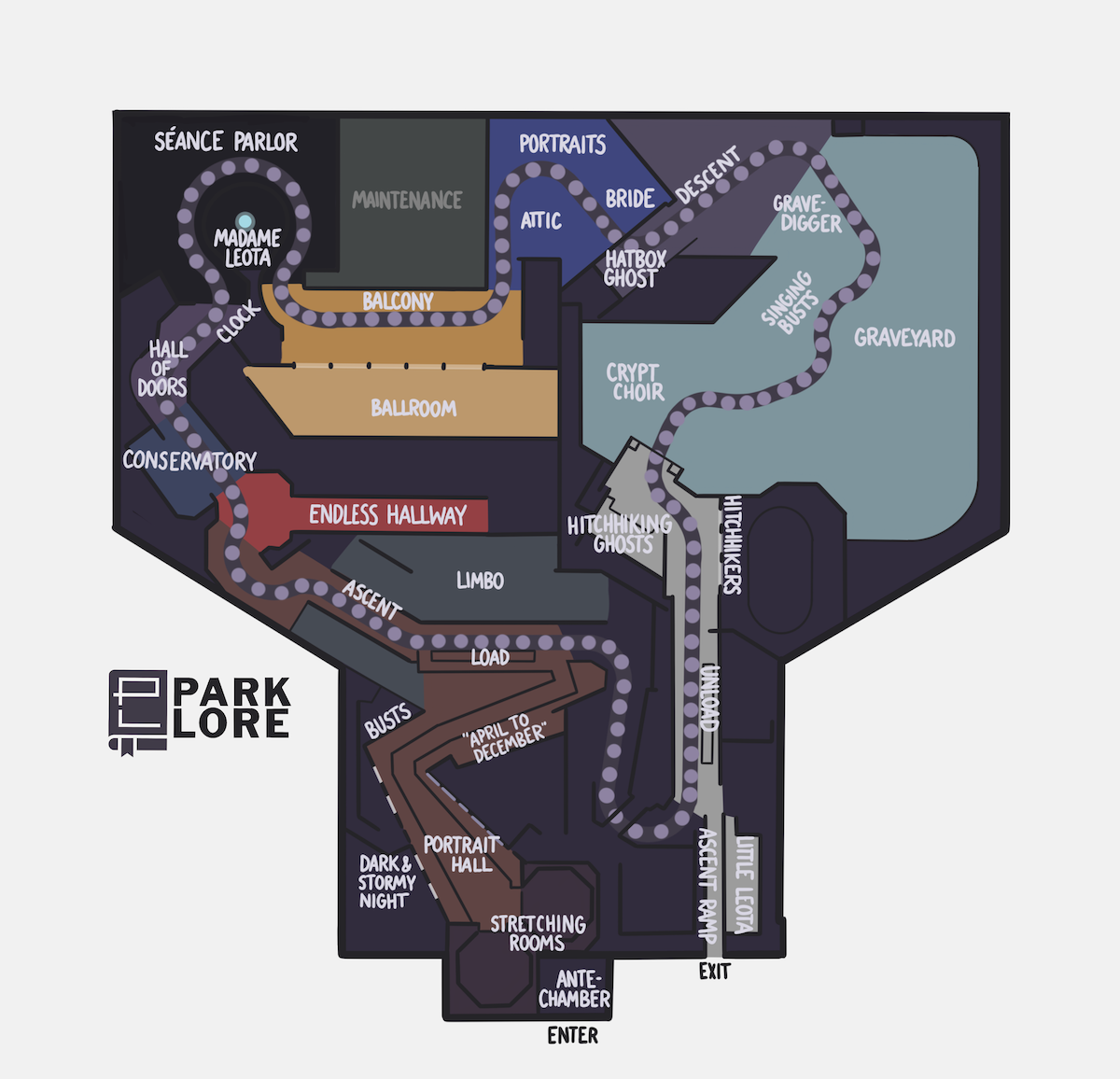
The original Haunted Mansion finally opened its doors in 1969. A fitting follow-up to Pirates of the Caribbean two years earlier, the New Orleans Square attraction includes a number of innovations, like the “Stretching Room” (which lowers guests to basement level so they can walk under the Disneyland Railroad and into the gargantuan, unseen showbuilding). Enormously high capacity and generally iconic, the ride is regarded as one of Disney’s finest, and certainly among the best “classic” dark rides on Earth.
B. Haunted Mansion (Magic Kingdom [1971] and Tokyo Disneyland [1983])
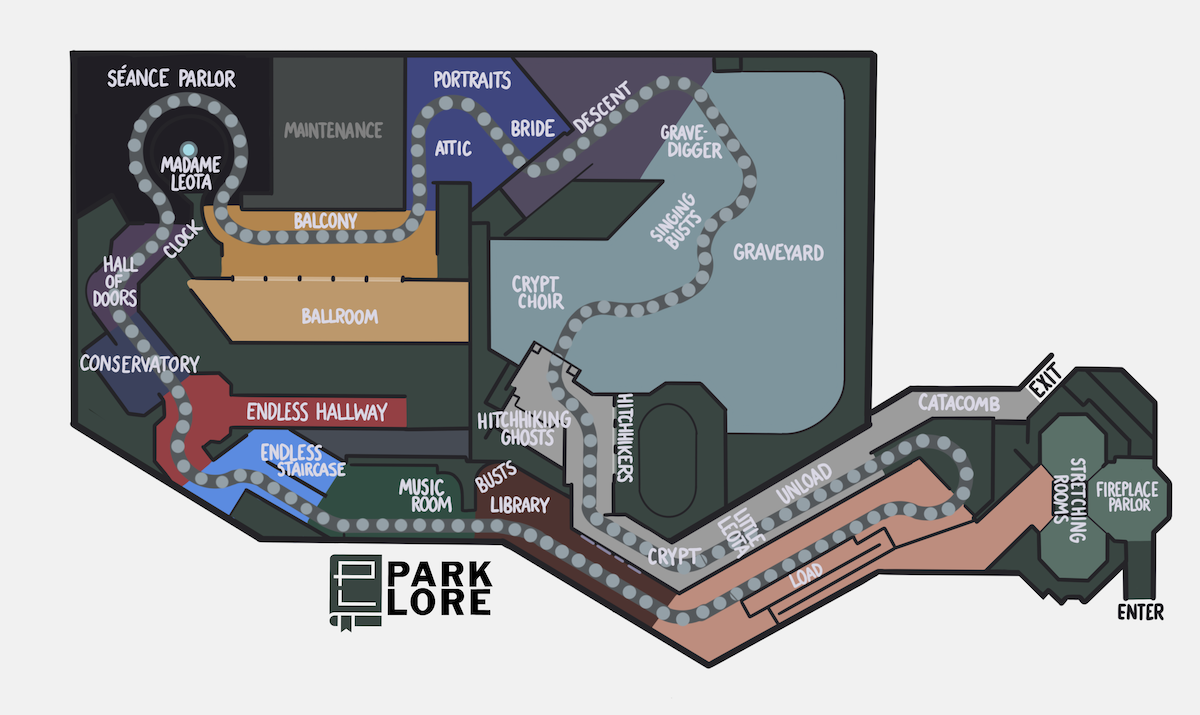
Though the park itself didn’t open until 1971, Magic Kingdom’s Haunted Mansion was essentially built in tandem with Disneyland’s, making the ride among the first in Florida to be completed. Though the ride’s facade was swapped from a New Orleans plantation house to a wind-swept New England coastal manor, many of its key scenes remain unchanged.
One well-known difference is that at Magic Kingdom, there’s no need to pass under the Railroad, so the “Stretching Room” isn’t an elevator. Instead of the floor descending, the ceiling rises to create a mostly-identical illusion. The biggest change in Florida, though, is that the showbuilding is essentially rotated 90 degrees relative to the manor facade, which added extra room for show scenes. Guests load in a Hallway rather than the otherworldly void, then travel through the Library, Music Room, and Endless Staircase, making Disneyland’s first scene (the Endless Hallway) fourth in Florida.
Tokyo Disneyland’s Haunted Mansion is a clone of Magic Kingdom’s except for a few slight edits. First, the same red brick manor facade is used in Tokyo, but added ‘fantasy’ elements (like stone griffons, shattered windows, and a gatekeeper’s house) more effectively communicate what’s inside to an audience without the same shared cultural association with ghosts, and help the ride fit in Fantasyland. Second, the “Endless Staircase” scene was never added, leaving the original void of day-glo spiders. Finally, Tokyo retains the original Attic scene, with pop-up ghouls and a silent bride.
C. Phantom Manor (Disneyland Paris, 1992)
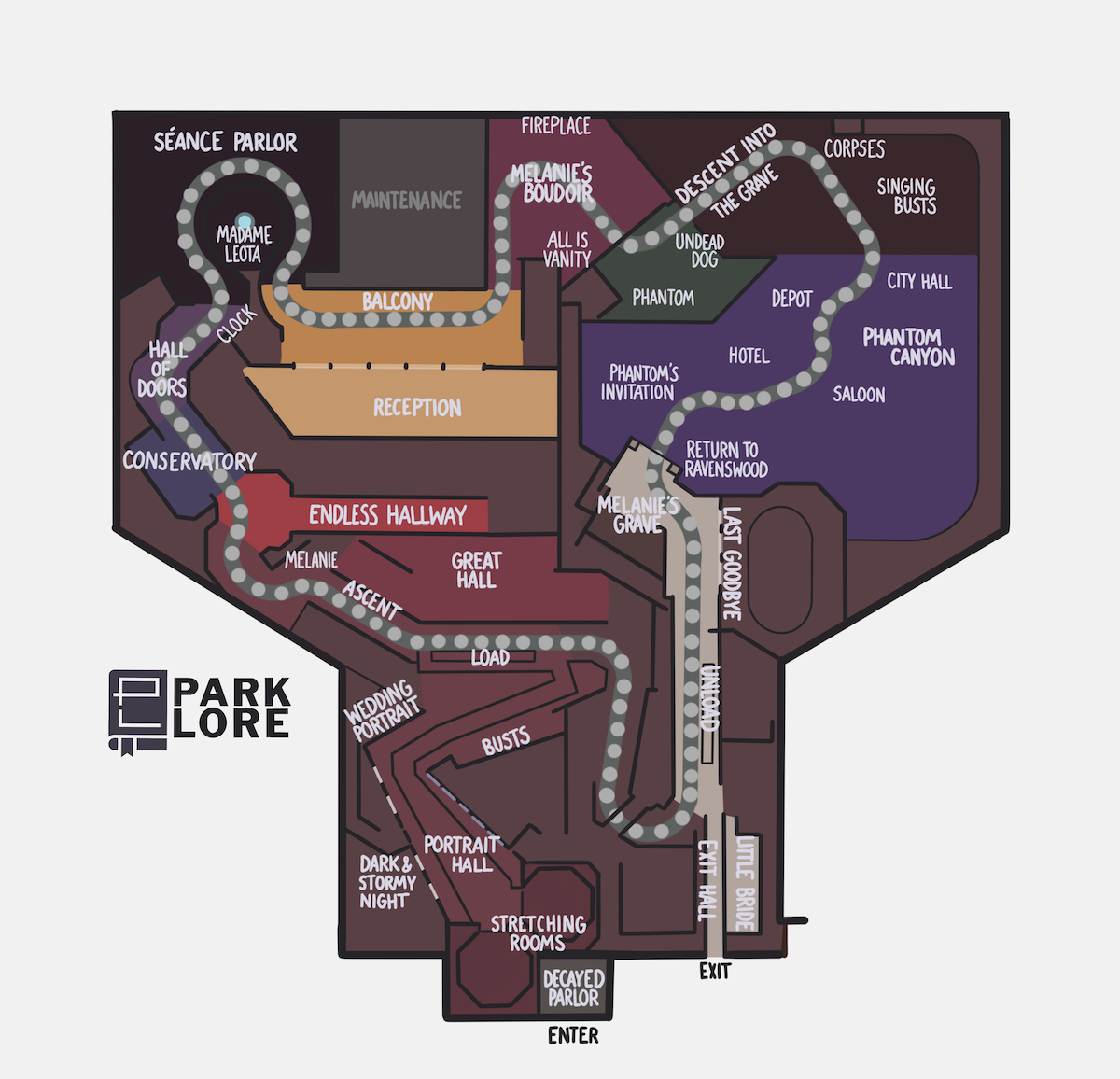
Layout-wise, Paris’ Haunted Mansion is a copy of Disneyland’s. Narratively, it’s something entirely unique. Tied into the mythology of the park’s Big Thunder Mountain, the Modern Marvel: Phantom Manor takes the bones of the Haunted Mansion and reforms a new story around them – the morbid, tragic tale of Melanie Ravenswood, whose love affair with a Big Thunder Mountain miner ends in tragedy, fracturing the cursed town of Thunder Mesa and setting loose a Phantom whose presence slowly drives the grieving bride mad.
Yeah… it’s heavy. Though Paris’ version of the ride includes many of Haunted Mansion’s iconic vignettes, each is recontextualized in a vast, depressing melodrama suited for a classic Western film with the weight and gloom of Gaston Leroux’s French novel “The Phantom of the Opera.” Once exiting Melanie’s Boudoir (a recast Attic), riders are literally lowered into a freshly-dug grave, where the cursed Thunder Mesa earthquake has unsettled steaming, rotting corpses. It all ends in Phantom Canyon, a Western town of ghosts and ghouls reigned over by the victorious Phantom himself… no happy endings in sight.
D. Mystic Manor (Hong Kong Disneyland, 2013)
We toured through the Modern Marvel: Mystic Manor in a standalone feature that’s a must-read for Imagineering fans, but suffice it to say that Hong Kong Disneyland’s one-of-a-kind dark ride has secured a spot in the pantheon of the best Disney Parks attraction.
Though in some ways it’s limiting to call Hong Kong Disneyland’s Mystic Manor a “Haunted Mansion,” there’s no doubt that the ride is a spiritual sequel of sorts, sending guests into a musical, mystical tour of an unusual home that some say is one of the best modern dark rides on Earth, and easily among the pantheon of Imagineering’s best-ever creations.
For supporting Park Lore’s ad-free, quality-over-quantity theme park storytelling for $2 / month or more, Members can view Mystic Manor’s layout above! For everyone else, make the jump to the third and final entry in our layout series – ONE & ONLY – to see Mystic Manor’s layout up close!
15. Peter Pan’s Flight
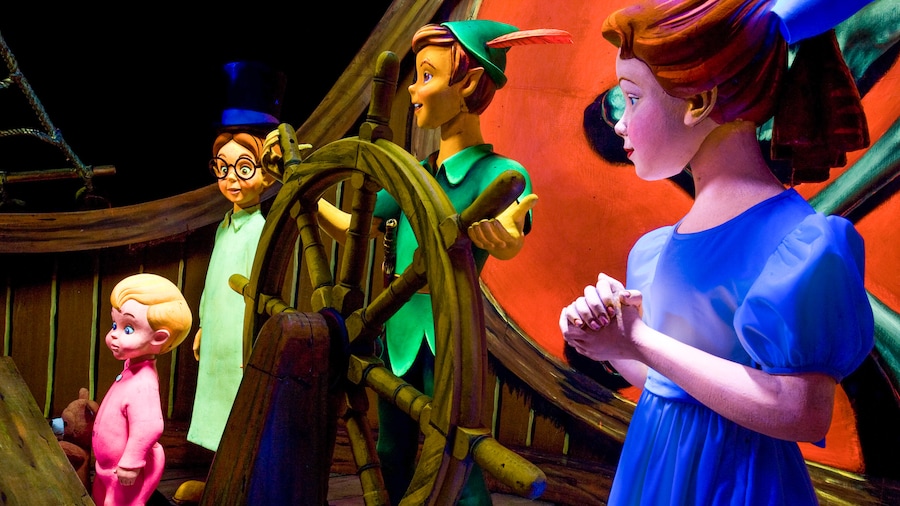
Every installation of Peter Pan’s Flight – even in the typically divergent Shanghai Disneyland – follows the same beats: departing from the Darlings’ nursery, sailing over a moonlit London, arriving at the fanciful Neverland, then diving in for a closer look at the swordplay between Peter Pan and the nefarious Captain Hook before heading back home. Obviously, the formula works, as Peter Pan’s Flight garners hour-long waits at every park. But that’s not to say there aren’t differences.
A. Peter Pan’s Flight (Disneyland, 1955 / 1983)
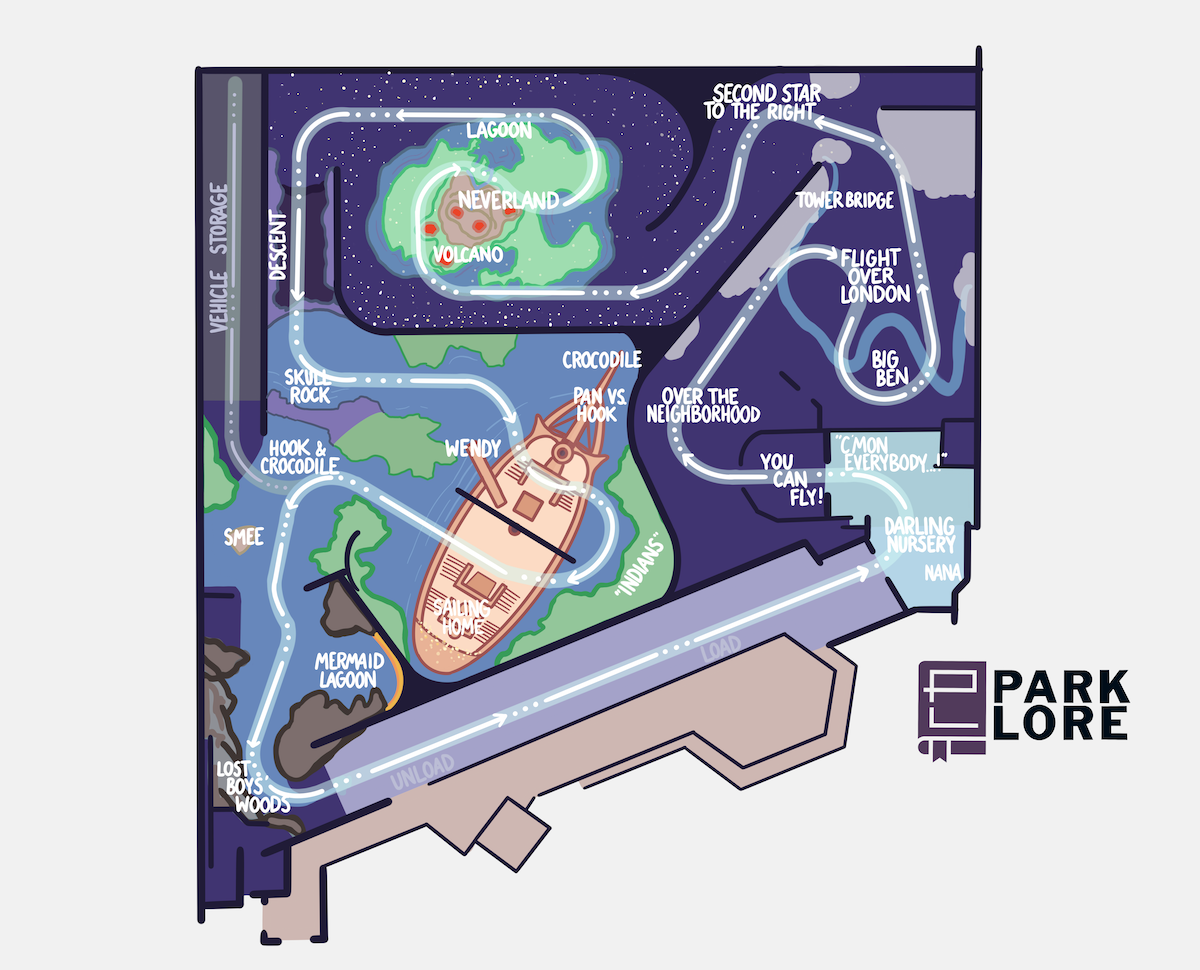
Unlike other Fantasyland dark rides, Disneyland’s Peter Pan’s Flight is mostly contained in four large rooms – the Nursery, London, Neverland from the air, and the “zoomed-in” Neverland and Jolly Roger – with transition spaces in between. It’s a joyful, fanciful journey that’s simple, but deeply effective.
Moreover, Disneyland’s version benefits from the same thing we’ve seen over and over again: plussing. As part of an extensive refurbishment in 2015, the ride gained new figures, new special effects, and new projection mapping that subtly but brilliantly brings the ride to life. From the shimmering “Second Star to the Right” to the glistening waterfalls, lapping tides, and steaming volcanoes of Neverland, such little touches are distinctly 21st-century, but without showboating. Instead, they feel as if they’ve always been there.
B. Peter Pan’s Flight (Magic Kingdom, 1971)
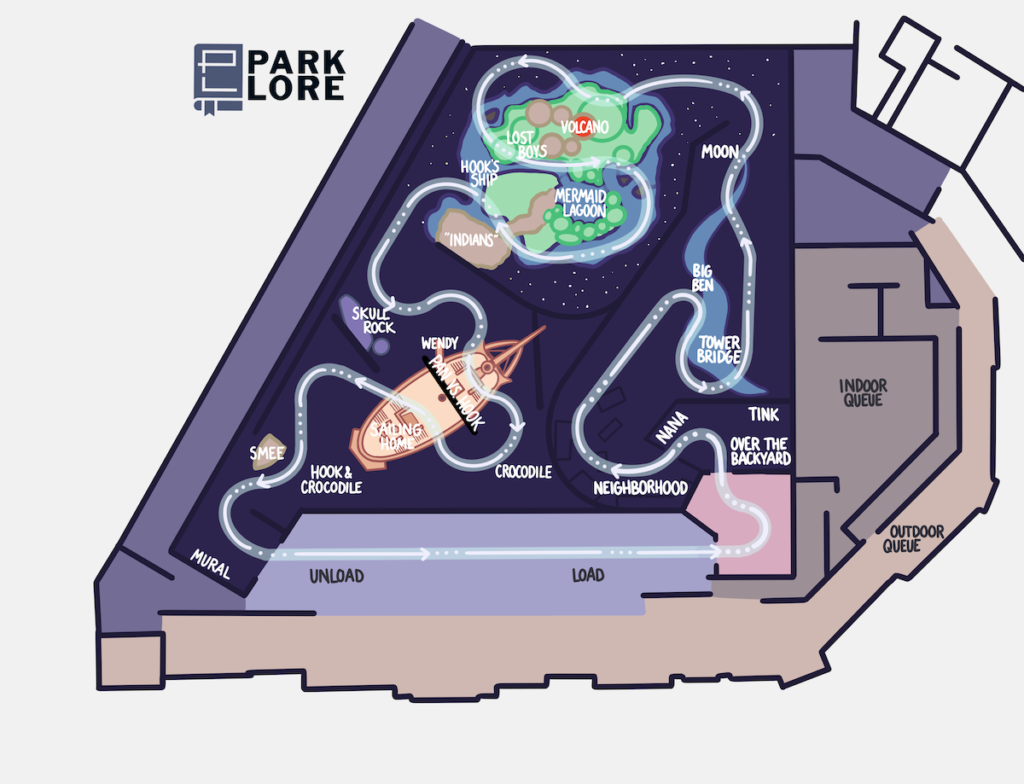
Unlike Disneyland’s stop-and-go loading, Magic Kingdom’s version of the ride has guests board from a continuously-moving belt. The Darlings’ nursery is set up differently, and Magic Kingdom’s ride features a cute scene where guests soar over the backyard and Nana the dog before “zooming out” to London. Whereas Disneyland’s ride features a miniature Neverland, then larger-scale vignettes of the Indian Village, Mermaid Lagoon, and Lost Boys’ Woods later on in the ride, Magic Kingdom’s ride does it all at once, with a larger Neverland that contains those vignettes within it.
Peter Pan’s Flight got a “plus” in Florida, too, but it wasn’t to the ride. Instead, the new Tangled-themed restrooms allowed Imagineers to repurpose old restrooms as an indoor queue for Peter Pan’s Flight. Part of the “Scene 1” initiative meant to add interactivity to long Standby waits, the line passes through various rooms of the Darling home where guests can interact with shadows and watch mini-shows.
16. The EMV Adventures
A. Indiana Jones Adventure: Temple of the Forbidden Eye (Disneyland, 1995)
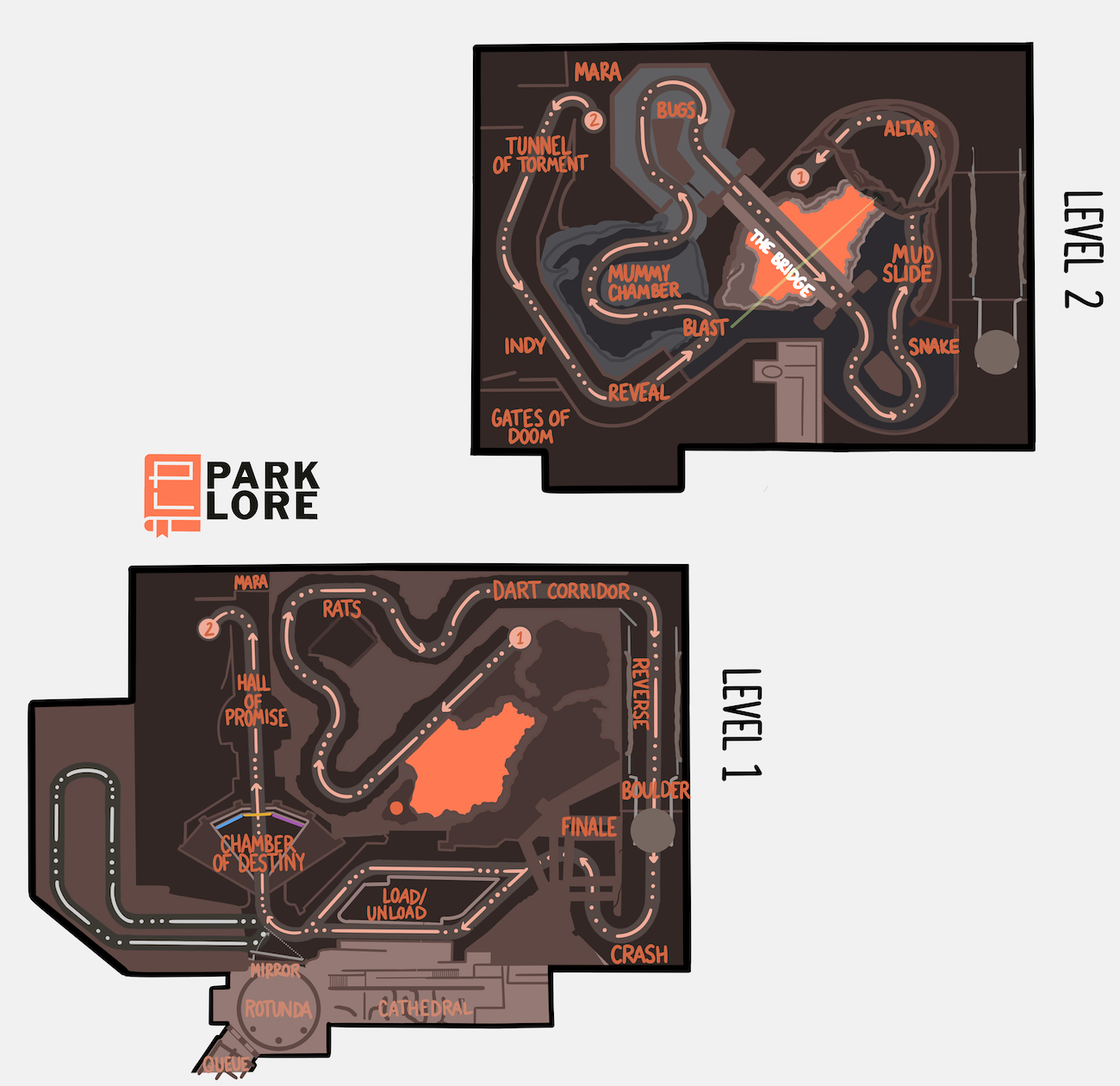
There are a lot of quantifiable reasons that a Disney World fan should visit Disneyland, but one of the biggest must be the Modern Marvel: Indiana Jones Adventure. Opened in 1995 – the height of the “Ride the Movies” era that also produced Star Tours, The Twilight Zone Tower of Terror, Fantasmic, and so much more – the ride is a blockbuster, one-of-a-kind E-Ticket that sees guests face off against the lost god Mara, whose promises of timeless youth, earthly riches, or future sight are balanced by an ancient curse set upon any who gaze into his dark and corroded eyes…
The birthplace of the EMV ride system – one of our Seven Modern Wonders of the Theme Park World – Indiana Jones Adventure is considered one of the greatest modern dark rides on Earth for good reason. Astounding in its detail, story, and scale, it’s an industry-changing landmark attraction.
Layout wise, the ride takes place across two floors. It begins in the Chamber of Destiny, where one of Mara’s three gifts is chosen for riders as its matching door comes to life and unseals. Riders ascent to Mara before being diverted to the Gates of Doom. It all comes to a head in “The Big Room,” where Jeeps dart in and out of caverns, shudder through booby traps, dodge lasers launched from Mara’s decaying face, and eventually cross an iconic suspension bridge over lava below. The ride’s inevitable finale – a face-off with a giant, rolling boulder – uses dozens of Imagineering tricks to leave guests screaming and laughing as John Williams’ iconic score crescendoes.
B. DINOSAUR (Disney’s Animal Kingdom, 1998)
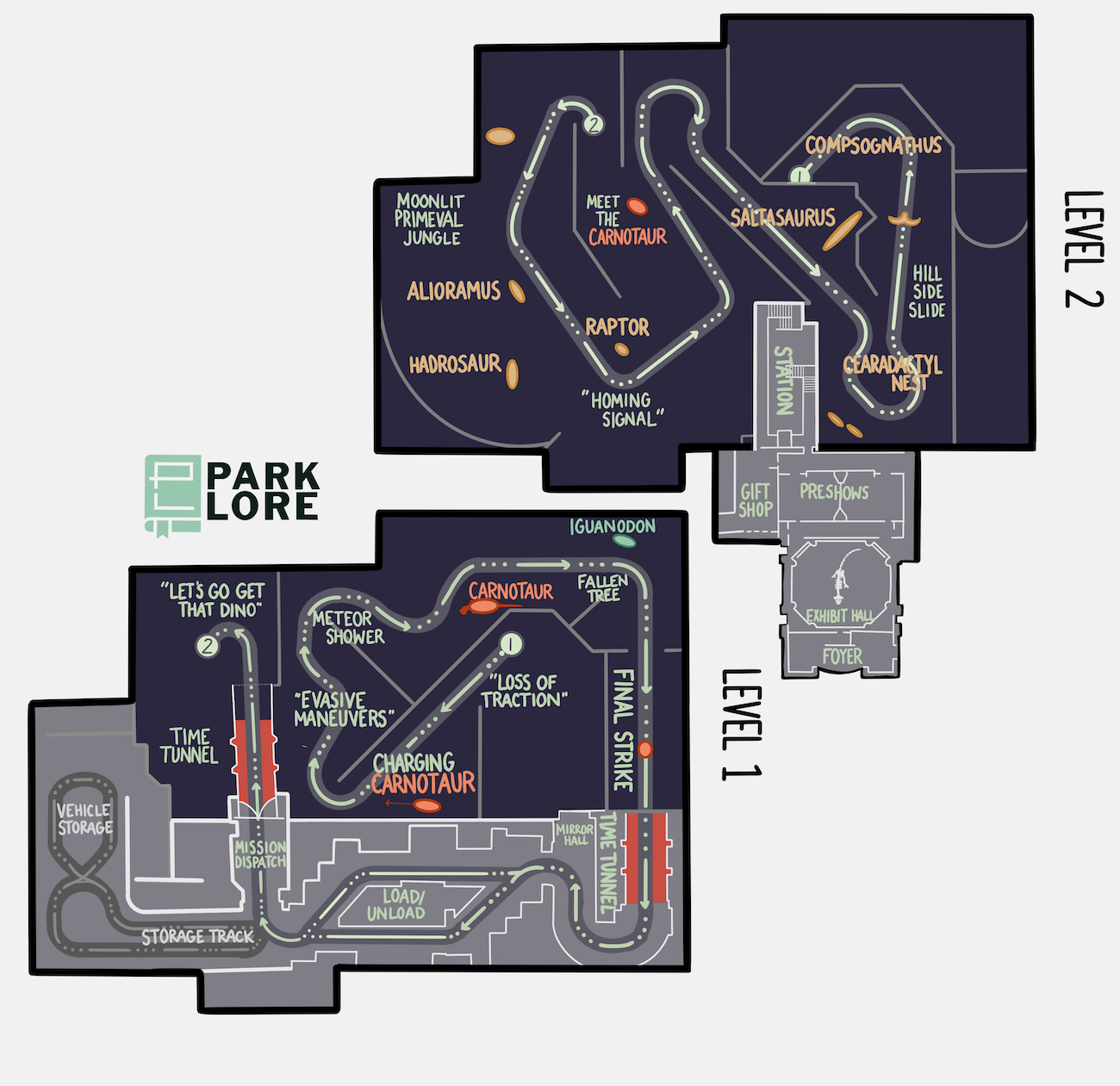
How did Disney’s Animal Kingdom end up with a near-identical recreation of Indiana Jones Adventure… without Indiana Jones? We dug into the prehistory of Disney World’s dino-ride in its own in-depth Modern Marvels: DINOSAUR feature.
Don’t misunderstand: even hardcore Imagineering fans have been known to reject the notion that Indiana Jones Adventure and Dinosaur could have nearly identical layouts, but it’s true! Aside from a few (literal) cut corners and re-angling, these two EMV-based dark rides are more or less clones layout-wise, but with such different decoration, it takes some convincing to be sure. (We provide that proof at the end of our Then & Now feature, where you can see the layouts overlaid with a slider to compare!)
So sure, these two might be different from our other “Here & There” pairs, but it’s worth seeing how the same ride system is used so differently in two Disney Parks.
17. Splash Mountain
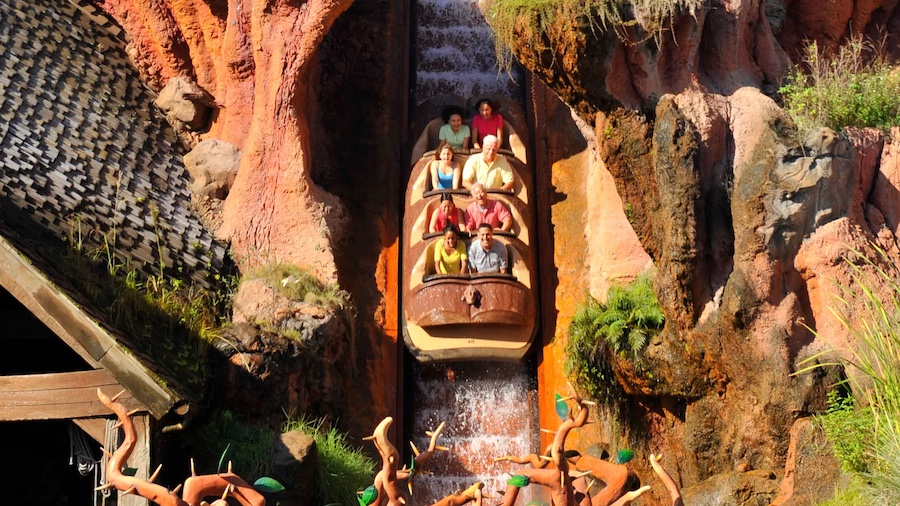
With a modern eye, it seems odd that in the 1980s, Imagineering constructed a major, E-Ticket attraction based on a film that – even by then – was considered controversial. Disney’s reasoning at the time was that Splash Mountain wasn’t really a ride through 1946’s Song of the South, but through the historical folk tales of Br’er Rabbit that made up the film’s un-controversial animated segments and powered the movie’s only real enduring element: its soundtrack (including perennial Disney favorite, “Zip-a-Dee-Doo-Dah”).
Today, the two U.S. installations of the ride are closed and in various stages of preparation for a rebirth as “Tiana’s Bayou Adventure,” themed to 2009’s hand-drawn animated film The Princess and the Frog. In so doing, Imagineers have been tasked with redeveloping a ride that’s got quite a complex and compact layout.
Despite appearances, Splash Mountain is basically contained within two separate showbuildings – the “mountain” and a hidden box behind it – with a flume that dips, rises, hops, and meanders through three distinct levels, often stacking scenes on top of each other. Try following the path of a log from load to unload below…
A. Splash Mountain (Disneyland, 1989)
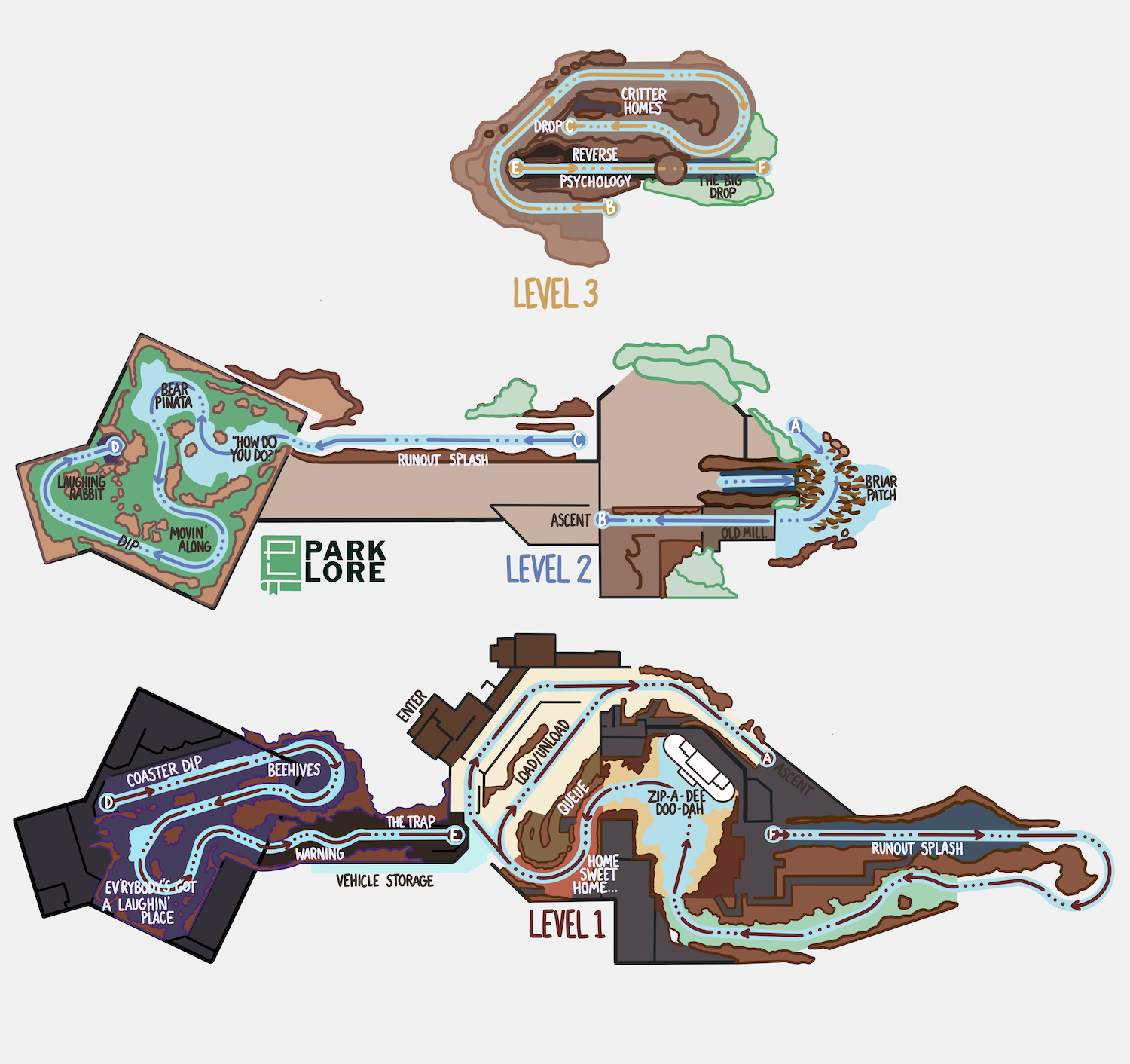
Disneyland’s Splash Mountain was made possible by the closure of “America Sings!”, a bicentennial musical revue that occupied Tomorrowland’s Carousel Theater after the Carousel of Progress moved to Florida. The show’s cast of a hundred critters was transported across the way to populate the musical ride based on the animated segments from Disney’s controversial, permanently-vaulted 1946 film The Song of the South.
Unbeknownst to most visitors, a bulk of the ride actually takes place in a hidden showbuilding far from the “Mountain” itself. The need for that warehouse to fit between the Haunted Mansion’s own showbuilding and the rest of Critter Country helps explain its odd shape. Most E-Tickets around the circumference of Disneyland have to find a way to travel under the Railroad. Instead, the Railroad travels right through Splash Mountain, providing views of the ‘Zip-a-Dee-Doo-Dah’ finale.
B. Splash Mountain (Magic Kingdom, 1992)
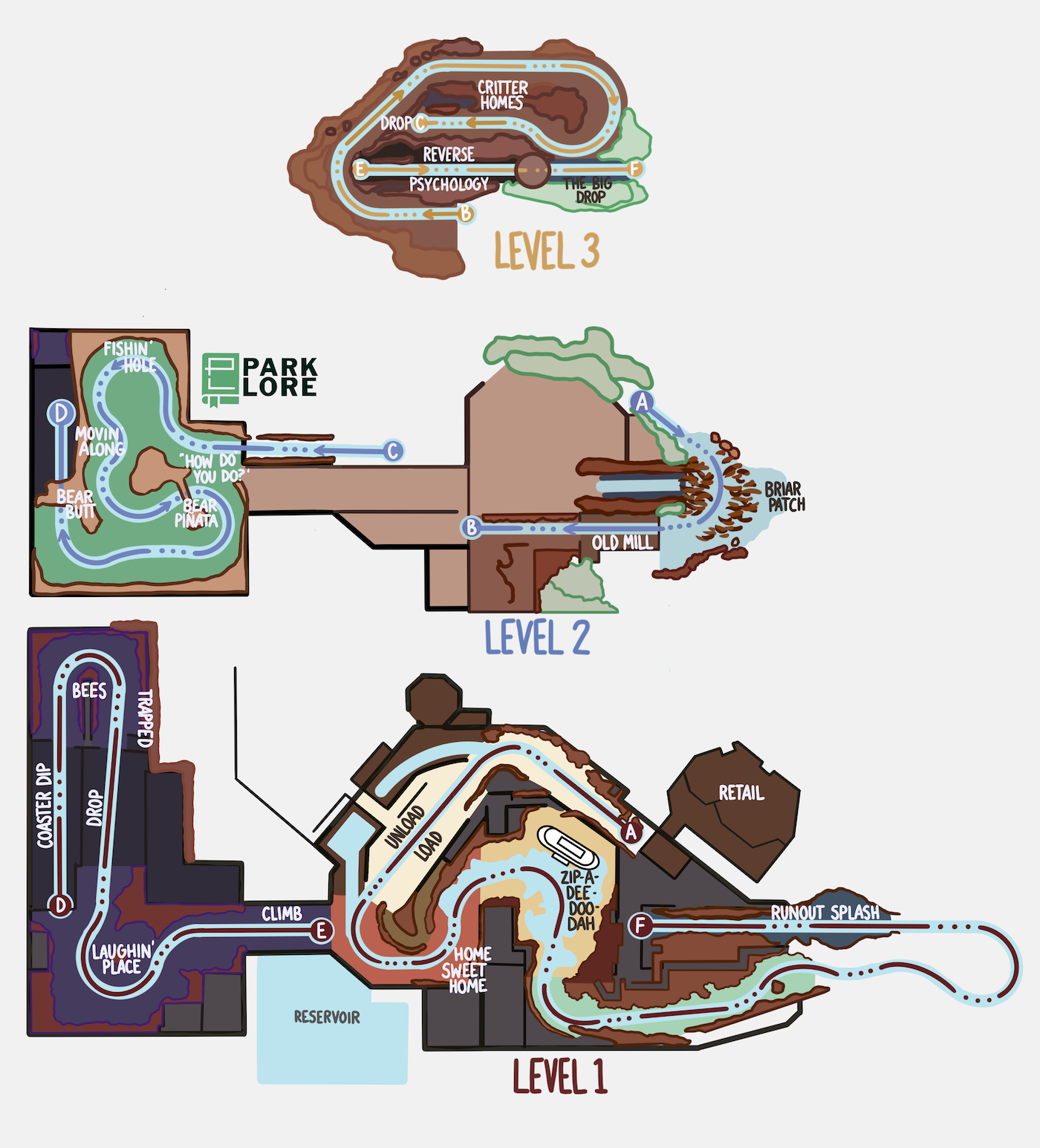
The “Mountain” section of Disney World’s Splash Mountain is nearly identical to Disneyland’s but for a slightly altered flume path and slightly re-staged scenes. Because it doesn’t have the same space limitations as Disneyland, though, Magic Kingdom’s ride has a much more standardly-shaped showbuilding to contain most of its dark ride scenes, including an additional drop. Like in California, the Railroad travels directly through the mountain to view the finale scene from above.
Unfortunately, Magic Kingdom doesn’t have a Critter Country land. That means Splash Mountain is set down in the park’s Frontierland. It doesn’t really make sense for a musical mountain of singing Southern animals to be wedged between the narratively-connected 1870s Western mining town and Big Thunder Mountain, but Imagineers did their best. Magic Kingdom’s version of the ride is painted darker and redder with scrubbier plants to match the desert landscape of Frontierland, and the ride’s music was rescored with banjos, dulcimers, and harmonicas to give a more rustic, western feel versus Disneyland’s jazzier brass and piano.
That’ll also make “Tiana’s Bayou Adventure” a tougher sell in Magic Kingdom than in Disneyland (where the ride could easily be absorbed into the neighboring New Orleans Square)… But again, it’s not like the Antebellum Georgia plantation parables of Uncle Remus were a great fit for the Wild West, either.



